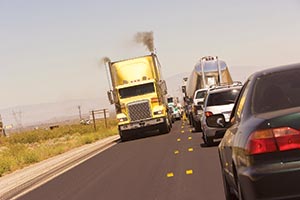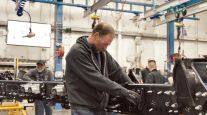State, Local Agencies Petition EPA for National Truck Rule on NOx

This story appears in the July 11 print edition of Transport Topics.
With publication of the Phase 2 federal greenhouse-gas final rule for trucks expected soon, 12 agencies from state and local government have petitioned the Environmental Protection Agency to quickly produce a national rule that would tighten nitrogen-oxide emissions from trucks.
The South Coast Air Quality Management District in metropolitan Los Angeles and the San Joaquin Valley Air Pollution Control District around Bakersfield, Fresno and Modesto were the main petitioners calling for the NOx rule at the same time that caps on carbon dioxide and other greenhouse gases are lowered.
The two California air quality districts were joined by agencies from eight other states in asking EPA for a 90% reduction in the limit on nitrogen-oxide compounds — down to 0.02 gram per brake horsepower-hour from the current ceiling of 0.2 gram, the limit since January 2010.
Furthermore, they asked for a proposal by mid-2017 and a final rule by Dec. 31 of the same year, saying the mandates should take effect in January 2022.
EPA said little of how officials would address the petitions and whether greenhouse gases and NOx should be considered as linked or separate issues.
“The agency will review the petition and respond appropriately,” EPA spokeswoman Christie St. Clair said.
In their petitions, the state and local agencies said they are continuing their interest in lower NOx limits because the compounds produce both photochemical smog and ground level ozone.
EPA and the National Highway Traffic Safety Administration sent their final version of Phase 2 to the White House Office of Management and Budget on June 3. EPA and NHTSA say they expect publication in the Federal Register next month, but some in the truck manufacturing industry said they expect the agencies to beat that estimate and publish late this month.
The proposed version of Phase 2, which came out in June 2015, calls for lowering truck GHG emissions in 2021, 2024 and 2027 but leaves the NOx limit at 0.2 gram throughout. EPA did lower nitrogen-oxide levels from trucks from 1998 to 2010, but then switched attention to greenhouse gases.
Truck and engine makers have consistently said lowering both types of emissions simultaneously is extremely difficult. Trade association executives representing truck and engine makers and trucking companies expressed concern about pursuing NOx and GHG reductions at the same time.
“We expect a very stringent, technology-forcing rule, and that assumes no change in NOx levels,” Jed Mandel, president of the Chicago-based Truck & Engine Manufacturers Association, said of his expectations for Phase 2. Mandel said he thinks that rule will come out by the end of this month, and truck transmission maker Eaton Corp. also predicts publication in late July.
Mandel said the rush to a new final NOx rule by the end of 2017 is “highly unrealistic” and said equipment options to meet the proposal are limited to two natural- gas engines from the Cummins Westport joint venture. The ISL G, a 9-liter engine, does meet the ultra-low NOx standard, while the ISX 12G might do it but has not been certified.
Mandel said the two Cummins Westport engines have their supporters, but they clearly cannot cover all of trucking’s many applications. Furthermore, while the national roster of compressed natural gas fueling stations is growing, there is nothing close to nationwide coverage for the fuel.
“We have concerns about costs, downtime and maintenance. Fleets need to think very carefully about this,” said Glen Kedzie, energy and environmental affairs counsel for American Trucking Associations, adding that ATA opposes the petitions.
The two California districts have some of the most stubborn smog problems in the nation, combining large populations with geographical impediments to air flow.
San Joaquin filed to EPA Administrator Gina McCarthy on June 22, following the South Coast petition to McCarthy on June 3. They were joined by agencies from Connecticut, Delaware, New Hampshire, Arizona, Nevada, New York, Ohio and Washington state.
The South Coast petition reminded EPA that the federal agency is ratcheting down the ozone limit to 75 parts per billion by 2031 from 80 ppb by 2023. A proposal calls for it to drop to 70 ppb by 2037.
The San Joaquin district’s executive director, Seyed Sadredin, said his area is far from reaching the 2031 ozone goal and if NOx limits for trucks don’t drop substantially, the district faces the “imposition of devastating economic sanctions” from EPA, including a ban on new and expanding businesses, loss of federal highway funds and federal nonattainment penalties.


